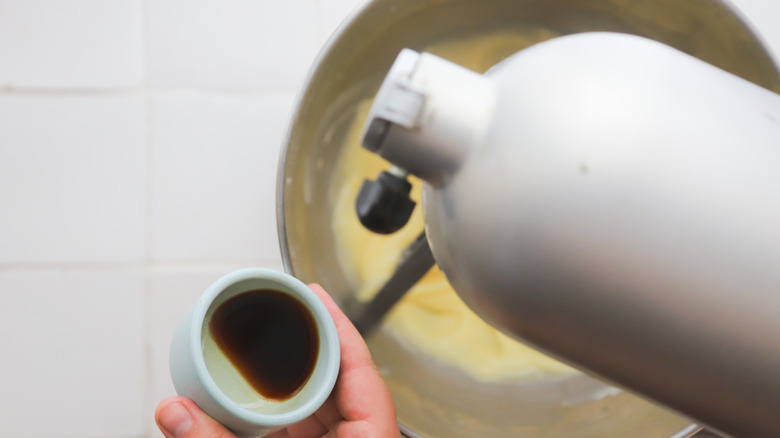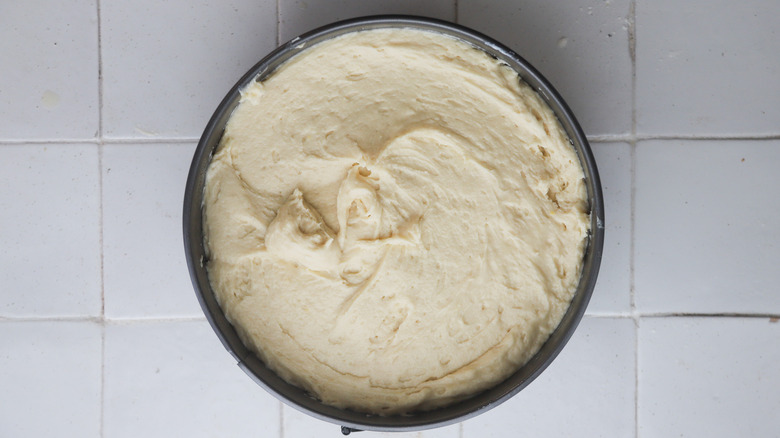Fig Upside-Down Cake With Bay Leaf Caramel
The classic pineapple upside-down cake, with its iconic ring of caramelized pineapples, has been a beloved dessert for generations. Traditionally made in a skillet or round cake pan, this cake features a buttery, brown sugar syrup base that, when baked, caramelizes the pineapples placed atop it. After baking, the cake is inverted, revealing the beautifully arranged fruit in all its glistening glory. The cake itself is usually a simple and fluffy vanilla-based sponge that doesn't overwhelm the pineapple.
The beauty of the upside-down cake format is its adaptability. You can freely exchange the pineapple for other fruits. Figs, for instance, have a natural sweetness and a jam-like consistency when baked, which works beautifully with the caramel base. Recipe developer Taylor Murray created a fig upside-down cake that has a brown sugar caramel infused with bay leaves to add an herbal note to this sweet dessert.
Gather the ingredients for fig upside-down cake
The star ingredients of this cake are the figs and the bay leaves. Look for black mission figs that are soft and ripe. The figs get tossed in a bit of brown sugar and that same sugar also forms the caramel along with butter. The cake itself is a simple vanilla cake with flour, sugar, baking powder, baking soda, salt, and full fat Greek yogurt. The yogurt adds tang and moisture, but could be substituted for crème fraîche or sour cream.
Step 1: Prepare the pan and figs
Preheat the oven to 325 F. Grease a 9-inch springform pan and line the bottom with parchment paper.
Step 2: Put the figs in the pan
Toss the fresh figs with 2 tablespoons of brown sugar. Arrange the figs, cut side down, in the prepared springform pan.
Step 3: Make the caramel
In a saucepan, combine 6 tablespoons butter with remaining 1 1/2 cups brown sugar and bay leaves. Bring to a boil over medium-low heat. Cook until just combined.
Step 4: Pour caramel into the pan
Immediately pour the hot caramel over the arranged figs in the pan. Let rest while you make the cake.
Step 5: Cream the butter and sugar
In a large mixing bowl, beat the remaining 6 tablespoons softened unsalted butter until creamy and fluffy. Add in 1 1/3 cup granulated sugar, beating until well combined.
Step 6: Add the eggs and vanilla
Add the eggs one at a time, beating well after each addition. Add the vanilla and beat until combined.
Step 7: Add the dry ingredients and yogurt
In a separate bowl, whisk together the flour, baking powder, baking soda, and salt. Add into the batter in alternating additions with the yogurt. Mix until just combined.
Step 8: Add the batter to the pan
Carefully spread the cake batter over the caramel and fig layer in the springform pan.
Step 9: Bake the cake
Place the cake in the preheated oven and bake for about 60 minutes, or until a toothpick inserted into the center of the cake comes out clean or with a few moist crumbs.
Step 10: Cool the cake
Allow the cake to cool in the pan on a wire rack for about 10 minutes. Then, carefully run a knife around the edge of the pan to loosen the cake. Remove the sides of the springform pan.
Step 11: Invert the cake
Invert the cake onto a serving plate, so the fig and caramel layer is on top. Remove the parchment paper. Serve warm or at room temperature.
Can I use other fruits or herbs instead of figs and bay leaves?
While figs and bay leaves offer a distinctive flavor combination, this cake is versatile. Pears, apples, or peaches can be excellent fruit substitutes. As for the herbs, rosemary or thyme can provide an aromatic depth similar to bay leaves. Experimenting with different combinations can result in exciting and delectable variations of this classic upside-down cake.
How do I store the leftover cake?
Store any leftover fig and bay leaf caramel upside-down cake in an airtight container at room temperature for up to 2 days. If you'd like to keep it for longer, consider refrigerating it, which will preserve its freshness for up to 5 days. Remember to let the cake come to room temperature before serving again, as this helps to retain its moist texture and full flavor profile.

- 13 ounces fresh figs (about 12), halved
- 1 1/2 cups plus 2 tablespoons brown sugar
- 12 tablespoons unsalted butter, divide
- 1 1/3 cup granulated sugar, divided
- 3 bay leaves
- 2 eggs, room temperature
- 1 tablespoons vanilla extract
- 2 cups all-purpose flour
- 1 1/2 teaspoons baking powder
- 1/2 teaspoons baking soda
- 1/2 teaspoon salt
- 1 1/4 cup Greek yogurt
- Preheat the oven to 325 F. Grease a 9-inch springform pan and line the bottom with parchment paper.
- Toss the fresh figs with 2 tablespoons of brown sugar. Arrange the figs, cut side down, in the prepared springform pan.
- In a saucepan, combine 6 tablespoons butter with remaining 1 1/2 cups brown sugar and bay leaves. Bring to a boil over medium-low heat. Immediately pour the hot caramel over the arranged figs in the pan.
- In a large mixing bowl, beat the remaining 6 tablespoons softened unsalted butter until creamy and fluffy. Add in 1 1/3 cup granulated sugar, beating until well combined.
- Add the eggs one at a time, beating well after each addition. Add the vanilla and beat until combined.
- In a separate bowl, whisk together the flour, baking powder, baking soda, and salt. Add into the batter in alternating additions with the yogurt. Mix until just combined.
- Carefully spread the cake batter over the caramel and fig layer in the springform pan.
- Place the cake in the preheated oven and bake for about 60 minutes, or until a toothpick inserted into the center of the cake comes out clean or with a few moist crumbs.
- Allow the cake to cool in the pan on a wire rack for about 10 minutes. Then, carefully run a knife around the edge of the pan to loosen the cake. Remove the sides of the springform pan.
- Invert the cake onto a serving plate, so the fig and caramel layer is on top. Remove the parchment paper. Serve warm or at room temperature.
| Calories per Serving | 401 |
| Total Fat | 14.1 g |
| Saturated Fat | 8.4 g |
| Trans Fat | 0.0 g |
| Cholesterol | 61.2 mg |
| Total Carbohydrates | 64.7 g |
| Dietary Fiber | 1.5 g |
| Total Sugars | 47.4 g |
| Sodium | 227.2 mg |
| Protein | 5.6 g |















